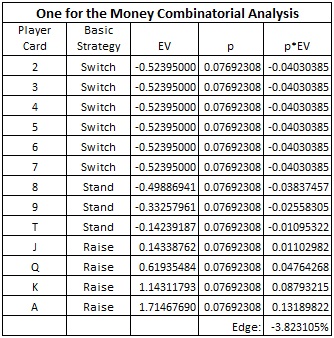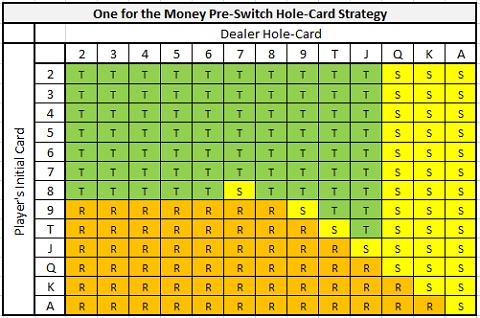One for the Money (OM) is a successful new casino game developed by a complete newcomer to the industry. The story of the quick rise of OM, from development, through licensing by SHFL (Shuffle Master), to success on the casino floor, is necessary reading if you have even a passing interest in creating and marketing your own casino table game. Now that OM is spreading, I decided to research its primary game protection issue: hole-card play.
OM is similar to the game Casino War, only the player is allowed to trade his card (like drawing cards in stud poker) and to raise (like doubling down in blackjack). In return for these privileges, the dealer receives two cards from which she chooses her highest ranking card to compete against the player. Ultimately, it is one player card versus one dealer card that compete to determine the outcome.
Here are the complete rules for OM:
-
The game can be dealt from any number of decks, but typically six or eight decks are used.
-
The rank of the cards is as usual, from Deuce (low) to Ace (high). The suit doesn’t matter.
-
The player makes an initial wager and receives a card. The dealer is dealt two cards, face-down. The player then has three options, to “stand,” “raise” or “switch."
-
“Stand.” The player’s initial card competes against the dealer.
-
“Raise.” In this case, the player places an additional wager equal to his original wager. The player’s initial card competes against the dealer.
-
“Switch,” sometimes referred to as “trade.” In this case, the player places an additional wager equal to his original wager. The player is then dealt a card that replaces his original card.
-
-
After a “switch” the player again has the option to either stand or raise, based on his switch card.
-
If the player stands after a switch, no further wagering takes place.
-
If the player raises after a switch, the player places an additional wager equal to his original wager.
-
The dealer then turns over her two cards and selects the card of highest rank.
-
The player’s card then competes against the dealer’s card.
-
If the player has the higher ranking card, the player is paid 1-to-1 on the totality of his wagers.
-
If the dealer has the higher ranking card, the player loses all of his wagers.
-
If the cards are of equal rank, the hand is a push and the player’s wagers are returned.
-
The game of OM is simple to learn and fast to play. It is also strategically interesting and volatile. The player has the possibility of two strategic decisions per hand and the possibility of winning or losing from 1 to 3 units in a hand. Given this combination of attributes, its rare success story is not a total surprise.
The analysis presented in this article considers the case when OM is dealt using six decks. The following table shows the combinatorial analysis for OM, along with basic strategy for the player’s first card. This computation shows a house edge of 3.823105%.

A complete combinatorial analysis of basic strategy, including correct raise/stand strategy after a switch, is given in this document:
For the player's initial decision:
-
The player should switch with 2, 3, 4, 5, 6, 7.
-
The player should stand with 8, 9, T.
-
The player should raise with J, Q, K, A.
If the player switches, basic strategy after the switch is:
-
The player should stand after a switch with switch card 2, 3, 4, 5, 6, 7, 8, 9, T.
-
The player should raise after a switch with switch card J, Q, K, A.
Next I will consider hole-card play against OM. If the AP is able to observe one of the dealer’s two hole-cards, then the AP can modify his strategy to take advantage of this additional information. The following table gives hole-card strategy based on the player’s initial card and observed dealer hole-card:

In the table above, S = “stand”, R = “raise” and T = “switch.” I apologize for using T for “switch,” but the letter S was already taken. You can think of “T” as “trade.”
The following file gives the full strategy for hole-card play, including what to do after a switch:
The following file gives the combinatorial analysis for an AP who uses the full hole-card strategy as given in the file above. It shows that the AP gets an edge of 11.7954% over the house. This analysis does not separate out post-switch decisions.
If you want to get into the dirt of the computation for hole-card play, the following file gives the complete combinatorial analysis for every hole-card strategy situation:
OM is a successful new game. However, there is very little information known about its advantage play vulnerabilities. This is a common problem with new games that can sometimes lead to a game's quick demise. It is unfortunate to see a good game get crushed when a simple fix will save it. That may be the case with OM if the casinos that offer it are not aware of its hole-card vulnerability. Every effort must be made to safeguard the dealer’s cards from hole-card exposure.
The hole-card fixes are easy. Here are three suggestions:
-
Wait until every player has completed all of their stand/raise/switch decisions before the dealer takes her two cards. This is similar to the “New York, New York” method for Three Card Poker.
-
Every dealer should be trained to safeguard the dealer’s hole-cards on every game. Audit your dealers frequently.


